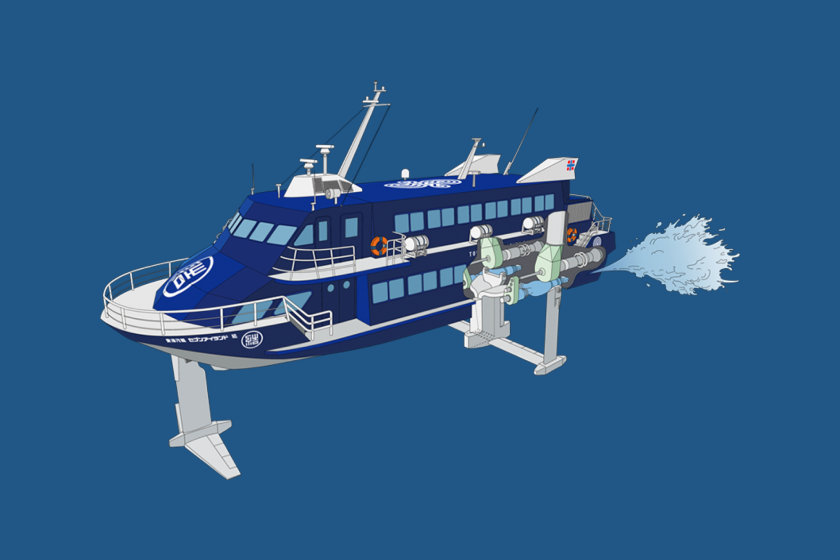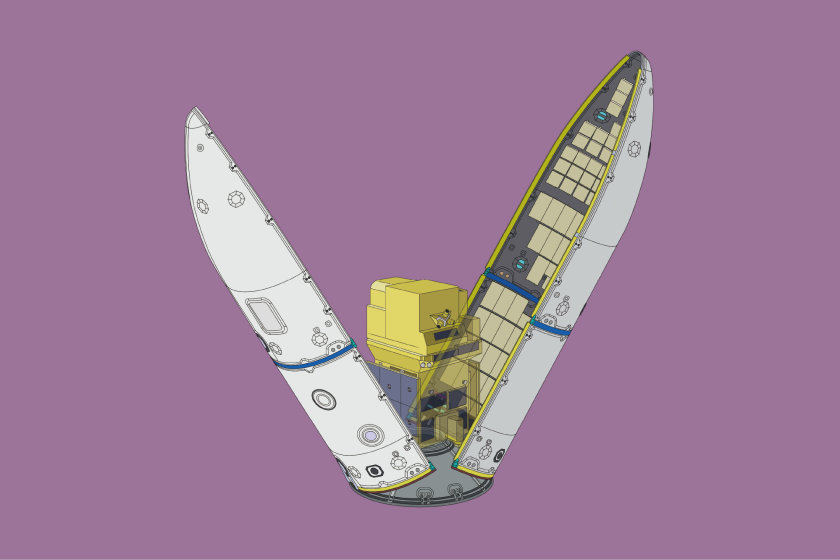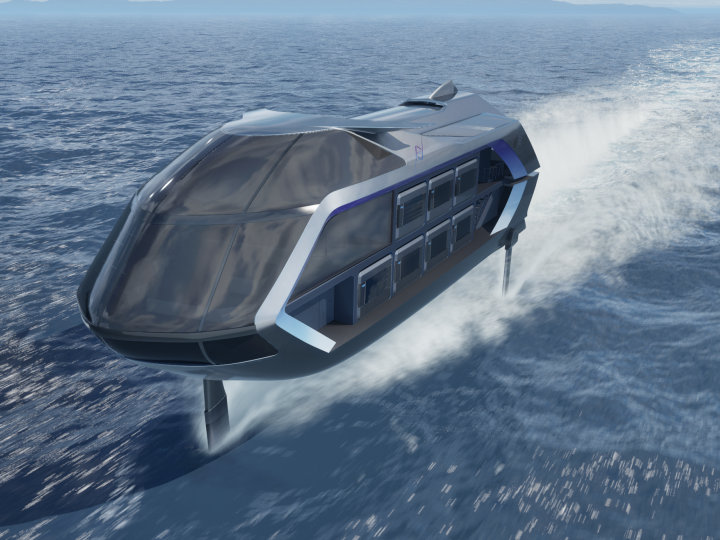Lime-Green Vitality: The Worldwide Dream of Riding

The lime-green color serves as a symbol of Kawasaki motorcycles. Established half a century ago, the visual identity (VI) of its motorcycle business is undergoing a new phase in which efforts to standardize the use of lime-green-based VI at Kawasaki outlets worldwide are underway to bring the brand’s vitality to a new level. However, this lime-green VI promotion inspires new changes also in those who see it.
Use of a globally-standardized VI gives the lime-green look new energy
Indonesia’s island of Lombok is located near Bali, and home to about three million residents. PT. Duta Intika, an exclusive Kawasaki motorcycle dealer in the island’s provincial capital of Mataram, has recently become one of the hottest places because of its trendy and cool appearance.
The top half of the store’s facade is solid black, under which there are three lime-green stripes, complemented by a white Kawasaki logo on the top right and the Duta Intika name on the bottom left. As the sun goes down and dusk settles in, the horizontal stripes and logos come to the fore, and warm light can be seen spilling out of the store’s entrance.
Duta Intika’s design is based on the standardized VI established by Kawasaki for its motorcycle business worldwide.
According to the shop’s owner, “Our store’s design has garnered a lot of attention and people from all parts of the island come to see it. Visitors come in to check out popular models like the Ninja 250, and I’m sure that many think to themselves, ‘Someday, I want to ride a bike like this.’ Although income levels are generally low on Lombok and many who take a seat on the vehicles in our store may simply be imagining what it would be like to own such a bike, the experience still inspires and empowers them.”
In the last ten years, Indonesia’s nominal GDP per capita has roughly tripled, yet the average person’s monthly salary is still only about 300 US dollars. This means that the Ninja 250, which sells for about 5,000 US dollars, is beyond the reach of most. Nevertheless, Kawasaki sells about 30,000 Ninja 250s per year in Indonesia, which made the local news.

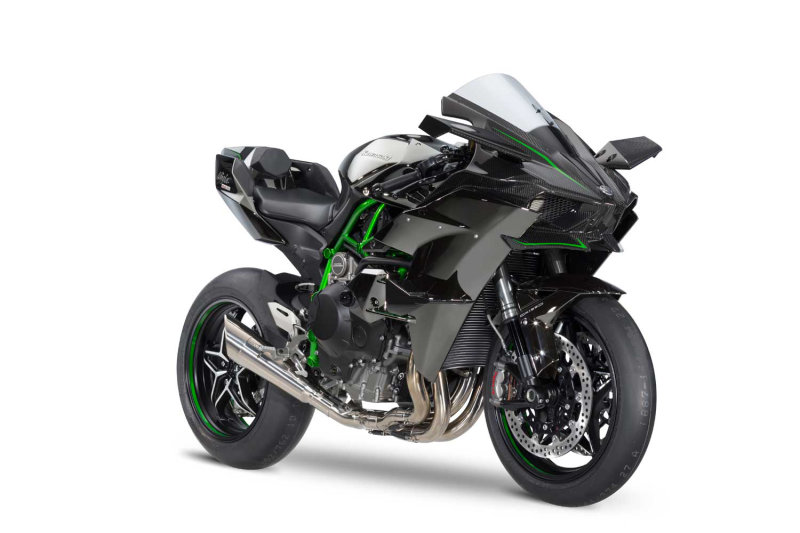
Yusuke Shimada, assistant manager at Kawasaki’s Motorcycle & Engine Company, who has supported dealers and helped disseminate Kawasaki’s VI in Indonesia from 2010 to 2015, explains, “In this region, the appearance of the Ninja 250 in trendy TV shows geared toward young audiences has helped popularize the shows, and in turn, we have taken advantage of this visibility to successfully market the 250s to discerning trend-setters.”
The widespread popularity of motorcycles in Indonesia is surpassed only by that in India and China, but the market in Indonesia, as well as the other two, is still focused on low-priced, compact models. However, Kawasaki takes a global strategy that prioritizes offering a singular value which no other brands do over increasing its market share, and the market of Indonesia is not an exception.
“When talking about lime-green Kawasaki motorcycles, people around the world associate the image with high-quality, high-performance sports bikes. Moreover, satisfaction with our products as property is high,” says Shimada. “It has become clear that this deeply-rooted confidence in our lime-green product image is growing steadily in emerging countries as well.”
In response to challenges such as market saturation and the 2008 global economic downturn, Kawasaki has been pursuing continued global standardization of its VI in order to further boost confidence in the overall brand. Today, the lime-green VI is also poised to foster increasing vitality for our brand.
Self-driven innovation rooted in undeniable appeal
Far from Lombok, efforts in Europe toward establishment of a globally-standardized Kawasaki VI and new sales promotion measures are already well underway. The visual style, combining a black background with three lime-green stripes and the Kawasaki logo, is based on the graphic design created by the Marketing Division of Kawasaki Motors Europe N.V. (KME) for our Factory Racing Team.
Numerous dealers feel that Kawasaki produces Japan’s sportiest, highest-performing bikes, yet there was still a shared awareness of the need to appeal to customers through a renewed lime-green VI in order to bounce back from the 2008 global economic downturn.
According to Manager Keisuke Goto, who was at the French branch of KME, “We changed our in-store display methods, updated our catalogs and undertook various other measures, but in all honesty, our modifications were accepted better by the dealers than we had expected, because the renewed Kawasaki VI was already very appealing, and they had a firmly established confidence in the lime-green brand.”
New store exterior designs and replacement of individual signage was costly for dealers, yet all of them were eager to move forward with the necessary changes. In the end, 180 shops in France updated their store designs and replaced signage in two year’s time.
“I was truly blown away by the results of the changes we implemented,” recalls Goto. While working to boost store quality through physical renovations, Goto realized that such efforts brought to the owners’ attention not only issues associated with the physical aspect of the shop but also the way of their operation and management, and gradually generated a desire to change both.

Goto elaborates: “Initially, we merely recommended changes to the stores’ appearances, but later began offering management training and store layout consultation, and took other steps to improve store management and customer service skills. Our products themselves inspire and motivate our dealers to ensure sales regardless of fluctuations in currency exchange. These transformations reminded me of the truly undeniable appeal of Kawasaki products symbolized by the lime-green VI."
Deputy Senior Manager Eiko Kirino of the Marketing Department is working to further global standardization of Kawasaki’s VI. “We are doing more here than merely selling motorcycles,” she states. “We want customers to really enjoy our outstanding products and, through their riding experience, make exciting new lives for themselves. Whether we’re selling bikes in developed nations or in emerging ones, our goal is to offer the pure joy that comes with fun-to-ride motorcycles. We want increasing numbers of customers to come to view lime-green as the color of pleasure by using our products.”
Zero compromises: the developmental approach that created a monster
The origin of the lime-green look dates back to 1968, when an affiliated sales firm based in the United States put in a request to a contracted color-design expert for color proposals that would enhance product recognition. That same year, a single Kawasaki bike that showed up in a race at Daytona Beach, Florida, stunned both race teams and audience members alike with its striking appearance. That bike, “the Kawasaki A1R,” was painted lime-green. At that time, the color was considered to be both unpleasant and unlucky in some Western countries, so its use was avoided in the racing world where superstitions were common. In light of this, the use of lime-green by Kawasaki’s racing team spoke to the company’s unconventional and daring spirit.
From then on, Kawasaki’s lime-green machine won victories in numerous other races and eventually acquired the nickname “The Green Monster”.
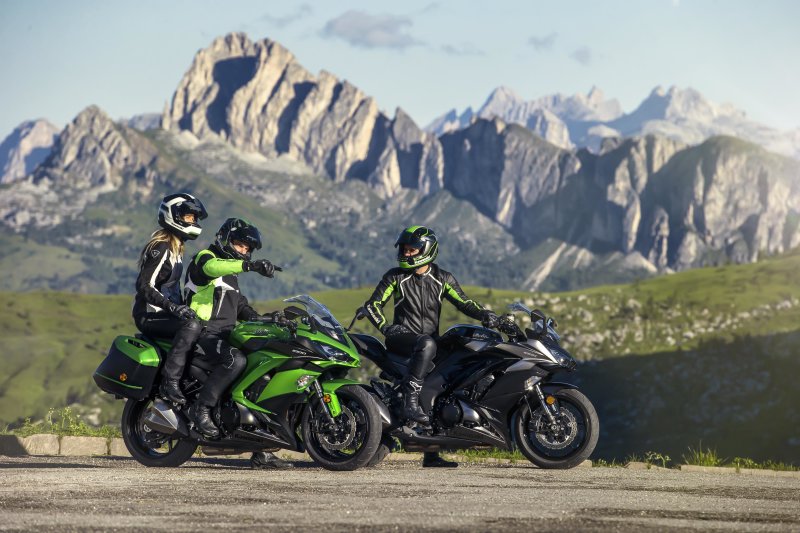

This color choice is symbolic of the devotion to self-challenge and the rigorous standards seen in Kawasaki’s approach to vehicle manufacturing.
As a comprehensive heavy industry manufacturer, Kawasaki made a firm decision regarding its motorcycle business: to consistently leverage the company’s collective resources, which led to a product development approach that allows for zero compromises.
The Ninja series, for example, has 15 different models ranging from the high-end H2/H2R and ZX-10R/ZX-10RR down to the simpler 300 and 250 models, yet Kawasaki carries out the same rigorous testing for all products in this series. Kawasaki makes sure that their motorcycles all exhibit our RIDEOLOGY principles: that our bikes should possess both power and gentleness, and that they are fun and rewarding to control. The company also makes full use of leading-edge technologies developed through their aerospace division and other business endeavors as part of an effort to ensure that each product pursues all possibilities. Engineers carry out repeated modifications and improvements until results of the required level are achieved consistently, using the same verification tests for each and every model in the series.

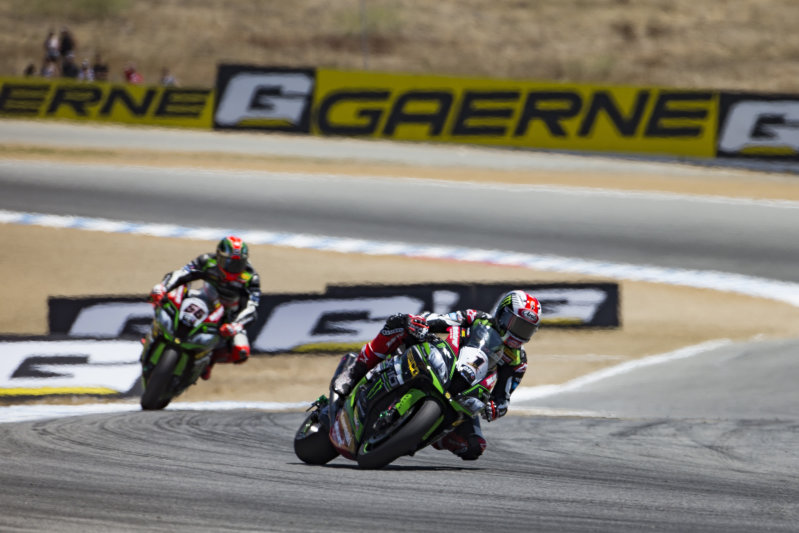
In short, even if the specs differ from model to model, the same underlying spirit should be found in each bike-the heart of our manufacturing approach epitomized by the lime-green color. As a result, even expert riders describe riding the popularly-priced Ninja 250 model as extremely fun and rewarding to control. Says Goto, “Not only has this made for very positive customer response, it has led to greater dealer satisfaction with Kawasaki than with any other producer.”
Even in the mature Japanese market, the company is pushing itself to go further. Plaza Osaka Tsurumi, an exclusive retail store in Tsurumi Ward, Osaka, operated directly by Kawasaki Motors Japan (KMJ), reopened in December 2016 following renovations. In addition to showcasing motorcycles, the newly redesigned shop features a luxurious interior design, and offers apparel and other products with the aim of introducing customers to new lifestyle possibilities. And further, KMJ plans to expand its current roster of six exclusive shops to roughly 120 throughout Japan.
Half a century has passed since the debut of the lime-green look. Yet, it tirelessly challenges both Kawasaki and its riders to continue pushing their own limits.
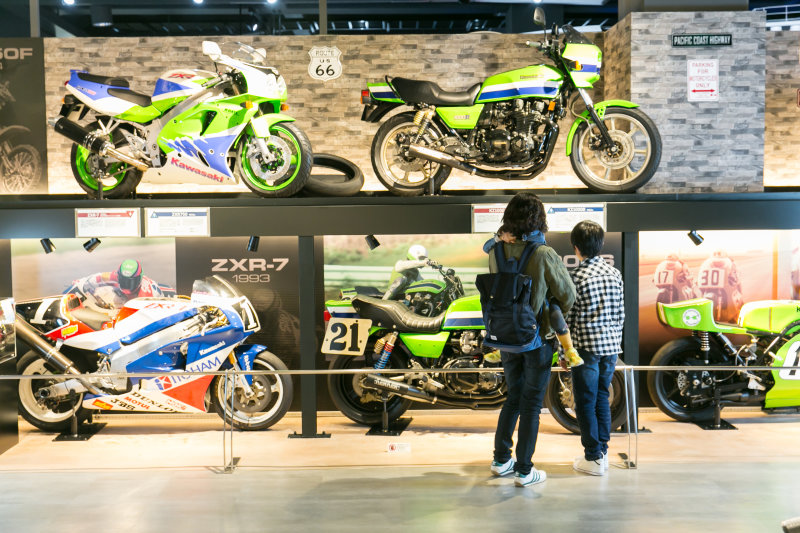
The Pride of Supremacy: Connecting the World to Its Future
People enjoy motorcycles in different ways from country to country and region to region. In the United States, for example, off-road riding in wild terrain such as deserts, fields, and hills is very popular. In Europe, long-distance cross-border touring with a tandem partner is common, meaning that both the driver’s and passenger’s opinions are vital when selecting a model. Appearing fashionable is also very important to customers in this part of the world. In the emerging markets in Asia, on the other hand, large motorcycles are rapidly becoming popular with the growing population of the wealthy, because having a large bike is considered to be a sign of success.
In all of these cases, the theme is the same: an earnest desire to ride the ultimate motorcycle, which makes a formidable “fun to ride” feeling. Kawasaki is viewed as an unrivaled brand precisely because it makes every effort to respond to this customer need.
Kawasaki’s pride and enthusiasm in this regard are expressed through the RIDEOLOGY philosophy as well as the river-shaped emblem-the Chinese character kawa (“river”) from “Kawasaki”-on the front of specific bikes. By displaying on the flagship Ninja H2 and H2R models the logo used at the time of Kawasaki’s founding, the company symbolizes the history, traditions, and comprehensive technical strengths developed through diverse business endeavors over the years.
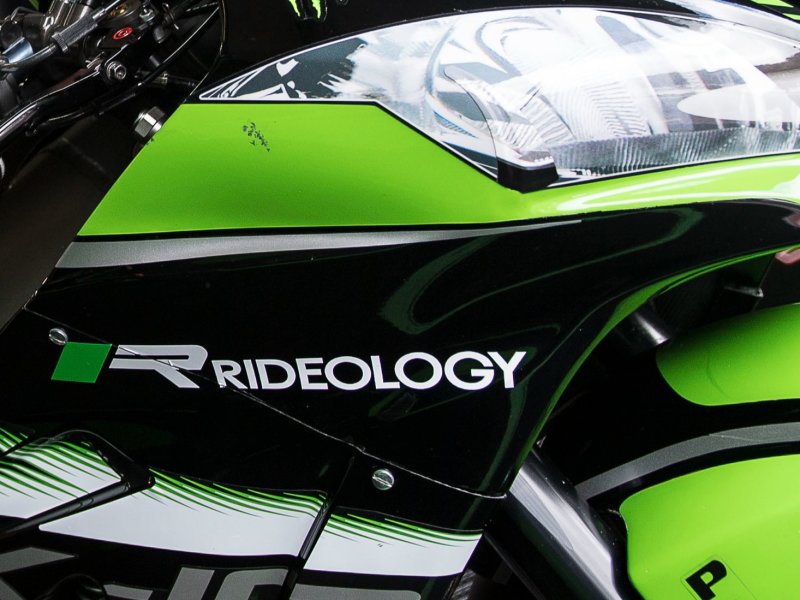

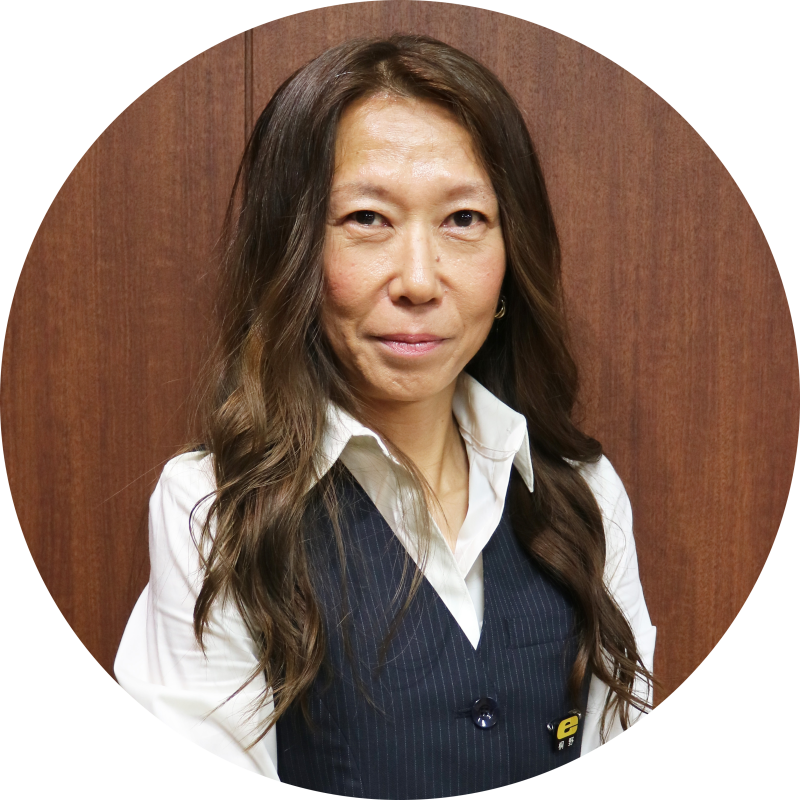
Marketing Department
and Manager of Marketing Section
Marketing & Sales Division
Motorcycle & Engine Company
Kawasaki Heavy Industries, Ltd.
Spreading “RIDEOLOGY” to All Who are Connected with Motorcycles Around the World through a Globally-Standardized VI
Making sure that the experience of riding a Kawasaki motorcycle is, above all, just plain fun-this is the mission of Kawasaki’s motorcycle business.
Our company specializes in high-performance bikes, exuding undeniable appeal to users in original ways and creating unparalleled products that will be talked about for years to come. Our product development philosophy revolves around the concept of RIDEOLOGY (ride + ideology), a term we coined to express our persistence (IDEOLOGY) in achieving an excellent RIDE. Toward this end, we at Kawasaki never hesitate to back our motorcycle products with every possible resource as a comprehensive heavy industry manufacturer. This approach to development, passed down for more than half a century, gives birth to new challenges for us to pursue.
As those in charge of marketing, it is our job to transform the passion of our development teams, the technologies they build into each product, and the thinking behind our RIDEOLOGY philosophy into concrete words and forms and then deliver them to the public. Whether in developed nations with maturing motorcycle markets or in emerging nations where the number of wealthy customers is rapidly growing, we aim to provide the sheer joy that comes from riding products that represent a crystallization of the RIDEOLOGY concept. We desire to offer such obvious pleasure that even potential customers who have no riding experience can feel that riding a Kawasaki bike should be a lot of fun.
Our current efforts to standardize Kawasaki’s global VI center on renovation of and improvements to existing shops, but also extend to discovering ways to leverage, in each country and region of the world, the vitality derived from the lime-green image. Furthermore, we are standardizing the naming and product imaging as family brand strategy in order to achieve consistent value throughout all product lines. When a customer who has experienced the fun of riding a Ninja 250 wants to upgrade to a higher class, it is our hope that, rather than simply thinking that they want to ride a 400 cc bike, they will express a desire to ride Kawasaki’s Ninja 400.
Everyone involved with Kawasaki motorcycles, from an engineer of the development team to a salesman of a dealership, has made up his mind to continue pursuing the RIDEOLOGY ideal.
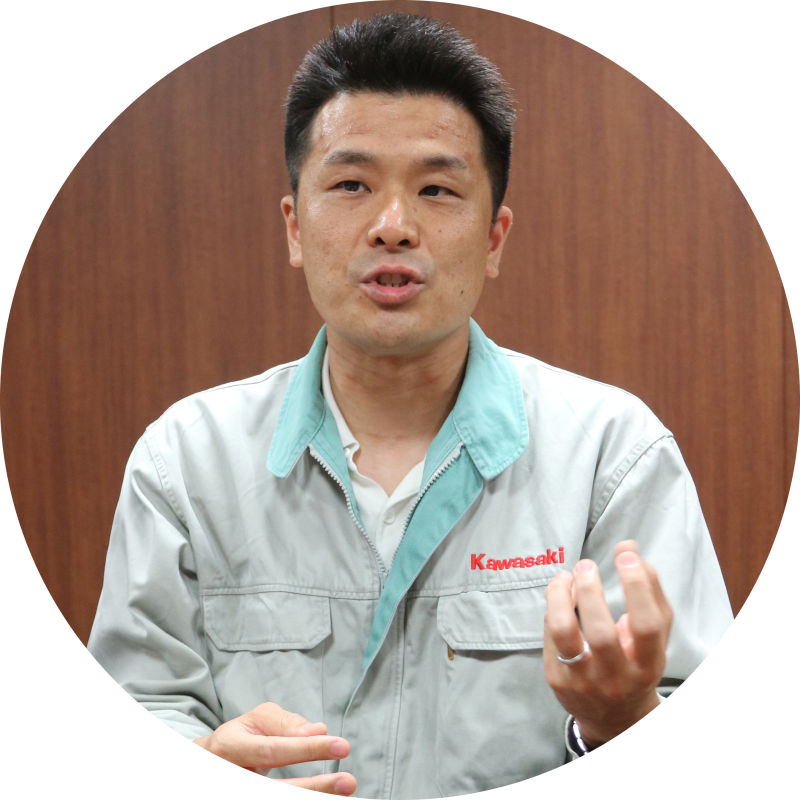
Sales Section 1, Sales Department 1
Sales Office, Sales & Control Division
Motorcycle & Engine Company
Kawasaki Heavy Industries, Ltd.
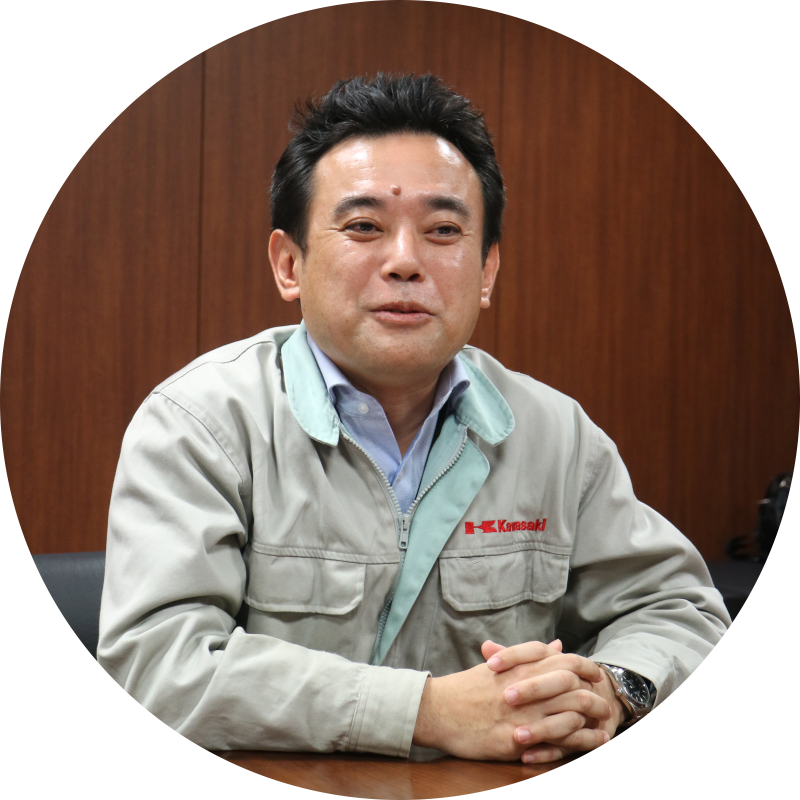
Sales Section 1, Sales Department 1
Sales Office, Sales & Control Division
Motorcycle & Engine Company
Kawasaki Heavy Industries, Ltd.



